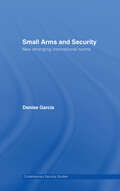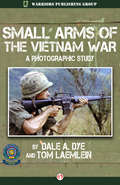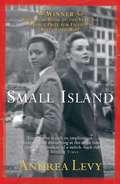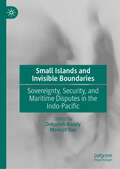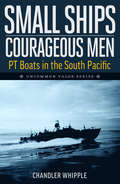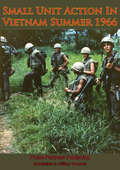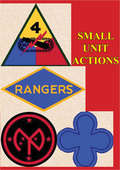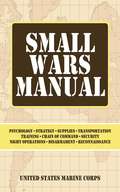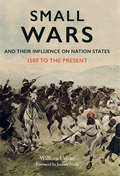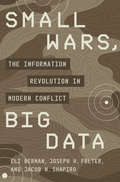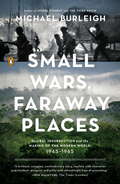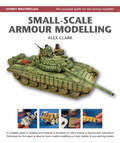- Table View
- List View
Small Acts of Defiance: A Novel of WWII and Paris
by Michelle Wright"In Small Acts of Defiance, Michelle Wright paints a beautifully intimate portrait that celebrates the courage and resilience of the human spirit."— Jane Harper, author of The SurvivorsA stunning debut WWII novel from award-winning short story writer Michelle Wright, about the small but courageous acts a young woman performs against the growing anti-Jewish measures in Nazi-occupied Paris.“Doing nothing is still a choice. A choice to stand aside and let it happen.”January 1940: After a devastating tragedy, young Australian woman Lucie and her mother Yvonne are forced to leave home and flee to France. There they seek help from the only family they have left, Lucie’s uncle, Gérard.As the Second World War engulfs Europe, the two women find themselves trapped in German-occupied Paris, sharing a cramped apartment with the authoritarian Gérard and his extremist views. Drawing upon her artistic talents, Lucie risks her own safety to engage in small acts of defiance against the occupying Nazi forces and the collaborationist French regime – illustrating pro-resistance tracts and forging identity cards. Faced with the escalating brutality of anti-Jewish measures, and the indifference of so many of her fellow Parisians, Lucie must decide how far she will go to protect her friends and defend the rights of others before it’s too late.
Small Arms Survey 2003: Development Denied
by Small Arms SurveyThe Small Arms Survey is now recognized as the principle international source of impartial and reliable information on all aspects of small arms. Its blend of information and analysis makes it an indispensable resource for policy-makers, officials and non-governmental organizations.
Small Arms Survey 2012
by Small Arms Survey GenevaThe Small Arms Survey 2012 seeks to increase our scrutiny of what is changing, and not changing, in relation to armed violence and small arms proliferation. Chapters on firearm homicide in Latin America and the Caribbean, drug violence in selected Latin American countries and non-lethal violence worldwide illustrate that security is a moving target; armed violence, both lethal and non-lethal, continues to undermine the security and wellbeing of people and societies around the world. The goal of curbing small arms proliferation, embodied in the UN Programme of Action, appears similarly elusive. Chapters on illicit small arms in war zones, trade transparency, Somali piracy and the 2011 UN Meeting of Governmental Experts highlight some of the successes, but also the continuing challenges, in this area. Country studies on Kazakhstan and Somaliland, along with the final instalment of the authorized transfers project, round out the 2012 edition.
Small Arms Survey 2014
by Small Arms SurveyThe Small Arms Survey 2014 considers the multiple roles of women in the context of armed violence, security, and the small arms agenda. The volume's thematic section comprises one chapter on violence against women and girls - with a focus on post-conflict Liberia and Nepal - and another on the recent convergence of the small arms agenda with that of women, peace and security. Complementing these chapters are illustrated testimonies of women with experience as soldiers, rebels and security personnel. The 'weapons and markets' section assesses the potential impact of the Arms Trade Treaty, presents the 2014 Transparency Barometer and an update on the authorized small arms trade, and analyses recent ammunition explosions in the Republic of the Congo. Additionally, it examines ammunition circulating in Africa and the Middle East, maps the sources of insurgent weapons in Sudan and South Sudan, and evaluates crime gun records in the United States.
Small Arms and Security: New Emerging International Norms (Contemporary Security Studies)
by Denise GarciaThis book examines the emergence of new international norms to govern the spread of small arms, and the extent to which these norms have been established in the policies and practices of states, regions and international organizations. It also attempts to establish criteria for assessing norm emergence, and to assess the process of norm development by comparing what actually happens at the multilateral level. If norm-making on small arms and related multilateral negotiations have mostly dealt with ‘illicit arms’, and most of the norms examined here fall on the arms supplier side of the arms equation, the author argues that the creation of international norms and the setting of widely agreed standards amongst states on all aspects of the demand for, availability, and spread of both legal and illegal small arms and light weapons must become central to the multilateral coordination of policy responses in order to tackle the growing violence associated with small arms availability. Small Arms and Security will be of interest to researchers and professionals in the fields of peace and conflict studies, global governance, international security and disarmament.
Small Arms of the Vietnam War
by Dale A. Dye Tom LaemleinWith modern military emphasis on whiz-bang weapons technology and the constant quest for things that make a bigger bang on the battlefield, it's easy to forget that at the dark heart of war stands an infantryman and his individual weapons. Those who understand warfare from research or from personal experience generally realize this about the conflicts that have plagued mankind since the dawn of time. Infantry weapons--often referred to as small arms--have fascinated soldiers and scholars for decades as they are the most personal aspects of combat. Small arms come into play when contact is close and potentially lethal. This was particularly true during the long, frustrating war in Vietnam, but much of the focus in studying that conflict has been either on aerial weapons--strike aircraft or armed helicopters--or on the originally much-maligned M16 rifle. There were huge numbers of other weapons used by both sides, but they are often ignored and rarely seen being used in combat action. This book solves that problem. Divided into easily digestible sections and preceded by cogent discussions of each weapon type, the authors have presented an intriguing collection of photographs that depict the primary small (and not so small) infantry arms most common on Vietnam battlefields. There are rare and stirring images here that depict what it was like to fight in the jungle-covered mountains and in the rice paddies. Viewing these images is like studying a primer about one of America's longest and deadliest wars.
Small Gods: A Discworld Novel (Discworld #13)
by Terry Pratchett“Pratchett’s Monty Python-like plots are almost impossible to describe. His talent for characterization and dialogue and his pop-culture allusions steal the show.”—Chicago TribuneNo sacred cow is left unskewered in this intriguing installment in Sir Terry Pratchett's internationally bestselling Discworld series, a divinely funny take on organized religion, petty gods, and the corrupting thirst for power.Religion is a competitive business in the Discworld. Everyone has their own opinion and their own gods of every shape and size—all fighting for faith, followers, and a place at the top. So when the great god Om accidentally manifests as a lowly tortoise, stripped of all divine power, it’s clear he’s become less important than he realized.Om needs an acolyte and fast. Enter Brutha, the Chosen One—or at least the only One available. He’s a simple lad whose highest ambition is tending his melon patch—until he hears the voice of a god calling his name. A small god for sure. But bossy as Hell.Brutha wants peace, justice, and love—but that’s hard to achieve in a world where religion means power, money is worshipped, and corruption reigns supreme. . . .The Discworld novels can be read in any order but Small Gods is a standalone.
Small Gods: Perspectives on the Drone
by Alex QuichoSmall Gods deconstructs the mythology of the drone: as soothing sound, aerial spy, and killing machine. When we say 'drone technology,' we can mean the tanpura, a plucked-string instrument originating in 16th century India, or the Gorgon Stare, an aerial surveillance technology designed by the US military - and evoke competing notions of terror and transcendence. Small Gods leans into this ambiguity. As each chapter focuses on the work of an artist with a unique understanding of 'the drone', the book illuminates myriad facets of these entangled technological entities. Opening with William Basinki's first glimpse of the ash-clouds of 9/11 - which spawned both The Disintegration Loops and the drone-driven War on Terror - the narrative then zooms into the representational sleights of hand of British and American artists preoccupied with the West's stake in endless drone wars. Its midsection lands us in the doldrums: where Anne Imhof's Angst, Anna Mikkola's drone-watched runner, and Atef Abu Saif's drone war memoir find maddening safety in boredom, raising questions about the trade-offs between security and surveillance. In the final section, the narrative uncouples from earthly oppression - we're freed to explore future and spirit worlds with artists including Korakrit Arunanondchai, Lawrence Lek, and WangShui, all of whom use drone technology to envision a future beyond the burden of colonialism, racism, exclusion or, simply, representation. Empty metal becomes a vessel for escape, connection, or intention; a future-facing spirit, a ride into the afterlife, a god or a ghost.
Small Island
by Andrea LevySmall Island by bestselling author Andrea Levy won the Orange Prize for Fiction, as well as many other awards, including the Commonwealth Writers' Prize and the Whitbread. Now a major BBC drama starring Benedict Cumberbatch and Naomie Harris, its enduring appeal will captivate fans of Maya Angelou and Zadie Smith. 'A great read... honest, skilful, thoughtful and important' - GuardianIt is 1948, and England is recovering from a war. But at 21 Nevern Street, London, the conflict has only just begun. Queenie Bligh's neighbours do not approve when she agrees to take in Jamaican lodgers, but Queenie doesn't know when her husband will return, or if he will come back at all. What else can she do? Gilbert Joseph was one of the several thousand Jamaican men who joined the RAF to fight against Hitler. Returning to England as a civilian he finds himself treated very differently. It's desperation that makes him remember a wartime friendship with Queenie and knock at her door. Gilbert's wife Hortense, too, had longed to leave Jamaica and start a better life in England. But when she joins him she is shocked to find London shabby, decrepit, and far from the golden city of her dreams. Even Gilbert is not the man she thought he was...(P)2015 Headline Publishing Group Ltd
Small Island (Nhb Modern Plays Ser.)
by Andrea LevySmall Island by bestselling author Andrea Levy won the Orange Prize for Fiction, as well as the Commonwealth Writers' Prize and the Whitbread. It is possibly the definitive fictional account of the experiences of the Empire Windrush generation. Now a major BBC drama starring Benedict Cumberbatch and Naomie Harris, its enduring appeal will captivate fans of Maya Angelou and Zadie Smith. 'A great read... honest, skilful, thoughtful and important' - GuardianIt is 1948, and England is recovering from a war. But at 21 Nevern Street, London, the conflict has only just begun. Queenie Bligh's neighbours do not approve when she agrees to take in Jamaican lodgers, but Queenie doesn't know when her husband will return, or if he will come back at all. What else can she do? Gilbert Joseph was one of the several thousand Jamaican men who joined the RAF to fight against Hitler. Returning to England as a civilian he finds himself treated very differently. It's desperation that makes him remember a wartime friendship with Queenie and knock at her door. Gilbert's wife Hortense, too, had longed to leave Jamaica and start a better life in England. But when she joins him she is shocked to find London shabby, decrepit, and far from the golden city of her dreams. Even Gilbert is not the man she thought he was...
Small Island: A Novel (Charnwood Large Print Ser.)
by Andrea LevySmall Island by bestselling author Andrea Levy won the Orange Prize for Fiction, as well as the Commonwealth Writers' Prize and the Whitbread. It is possibly the definitive fictional account of the experiences of the Empire Windrush generation. Now a major BBC drama starring Benedict Cumberbatch and Naomie Harris, its enduring appeal will captivate fans of Maya Angelou and Zadie Smith. 'A great read... honest, skilful, thoughtful and important' - GuardianIt is 1948, and England is recovering from a war. But at 21 Nevern Street, London, the conflict has only just begun. Queenie Bligh's neighbours do not approve when she agrees to take in Jamaican lodgers, but Queenie doesn't know when her husband will return, or if he will come back at all. What else can she do? Gilbert Joseph was one of the several thousand Jamaican men who joined the RAF to fight against Hitler. Returning to England as a civilian he finds himself treated very differently. It's desperation that makes him remember a wartime friendship with Queenie and knock at her door. Gilbert's wife Hortense, too, had longed to leave Jamaica and start a better life in England. But when she joins him she is shocked to find London shabby, decrepit, and far from the golden city of her dreams. Even Gilbert is not the man she thought he was...
Small Islands and Invisible Boundaries: Sovereignty, Security, and Maritime Disputes in the Indo-Pacific
by Debasish Nandy Monojit DasThis book offers a comprehensive exploration of the strategic, economic, and environmental challenges facing this critical region. It aims to fill a gap in academic research by focusing specifically on the multifaceted issues of small island disputes, territorial claims, and their implications for regional and global security. The book is distinctive due to its interdisciplinary approach, incorporating perspectives from international relations, security studies, environmental science, and maritime law. It aims to satisfy the needs of scholars, policymakers, and practitioners seeking to understand the complexities of the Indo-Pacific region and develop informed strategies for regional stability and cooperation. It is designed to offer readers a thorough understanding of the Indo-Pacific's complex geopolitical landscape. By addressing strategic, economic, and environmental challenges, the book will be invaluable for scholars, policymakers, and students. The special features like maps, tables, figures, and case studies, will facilitate a deeper comprehension of the region&’s disputes and strategic significance, making it an essential resource for anyone engaged in studying or working within the realm of Indo-Pacific geopolitics.
Small Pleasures: A Novel
by Clare ChambersIn the best tradition of Tessa Hadley, Kazuo Ishiguro, and Ann Patchett—an astonishing, keenly observed period piece about an ordinary British woman in the 1950s whose dutiful life takes a sudden turn into a pitched battle between propriety and unexpected passion."With wit and dry humor...quietly affecting in unexpected ways. Chambers' language is beautiful, achieving what only the most skilled writers can: big pleasure wrought from small details."--The New York TimesLONGLISTED FOR THE WOMEN'S PRIZE FOR FICTION1957: Jean Swinney is a feature writer on a local paper in the southeast suburbs of London. Clever but with limited career opportunities and on the brink of forty, Jean lives a dreary existence that includes caring for her demanding widowed mother, who rarely leaves the house. It’s a small life with little joy and no likelihood of escape.That all changes when a young woman, Gretchen Tilbury, contacts the paper to claim that her daughter is the result of a virgin birth. Jean seizes onto the bizarre story and sets out to discover whether Gretchen is a miracle or a fraud. But the more Jean investigates, the more her life becomes strangely (and not unpleasantly) intertwined with that of the Tilburys, including Gretchen’s gentle and thoughtful husband Howard, who mostly believes his wife, and their quirky and charming daughter Margaret, who becomes a sort of surrogate child for Jean. Gretchen, too, becomes a much-needed friend in an otherwise empty social life.Jean cannot bring herself to discard what seems like her one chance at happiness, even as the story that she is researching starts to send dark ripples across all their lives…with unimaginable consequences.Both a mystery and a love story, Small Pleasures is a literary tour-de-force in the style of The Remains of the Day, about conflict between personal fulfillment and duty; a novel that celebrates the beauty and potential for joy in all things plain and unfashionable.
Small Pleasures: Longlisted for the Women's Prize for Fiction
by Clare ChambersLONGLISTED FOR THE WOMEN'S PRIZE FOR FICTIONA BBC 2 'BETWEEN THE COVERS' BOOK CLUB PICK'Wonderful' RICHARD OSMAN'Perfect' INDIA KNIGHT'Beautiful' JESSIE BURTON'Witty and sharp' DAVID NICHOLLS1957, the suburbs of south east London. Jean Swinney is a journalist on a local paper, trapped in a life of duty and disappointment from which there is no likelihood of escape. When a young woman, Gretchen Tilbury, contacts the paper to claim that her daughter is the result of a virgin birth, it is down to Jean to discover whether she is a miracle or a fraud. As the investigation turns her quiet life inside out, Jean is suddenly given an unexpected chance at friendship, love and - possibly - happiness.'Gorgeous . . . I could not recommend it more' PANDORA SYKES'Remarkable . . . Small Pleasures is no small pleasure' THE TIMES'Irresistible . . . wry, perceptive and quietly devastating' MAIL ON SUNDAY
Small Ships Courageous Men
by Chandler WhippleSmall Ships, Courageous Men, first published in 1962 as Lt. John F. Kennedy— Expendable!, is an action-packed look at the role played by U.S. Navy PT Boats in the South Pacific during the Second World War. New to the Navy, PT boat tactics and armament were just being developed and tested by their crews, who would set-off on their missions against much larger and better-armed ships of the Japanese. Featured is an in-depth look at the missions and fate of the PT-109, skippered by a young John F. Kennedy, and the story of the 109's crew struggle to survive after the craft's collision with a Japanese destroyer. During the war, author Chandler Whipple was a lieutenant in the U.S. Navy. Included are 11 pages of photographs and maps.
Small Town Librarian
by John Leggett Jones<p>A small town librarian discovers a world of danger and excitement in a magical book that transports her to WWII Normandy.<p> <p>Emma Schultz had big dreams of leaving her small hometown. But when her father died and her mother became ill, it fell to Emma to pick up the pieces. Rather than go off to college and lead an exciting life as a writer in New York City, she stayed in Kansas, taking on her mother’s job as the town librarian. As time goes by, Emma marries a good man, but she cannot help feeling despair as she faces a life of dull routine.<p> <p>Then one day, an elegant woman enters the library and gives Emma a mysterious book, offering no explanation except “This book will help you.” And soon Emma finds that, every time she opens it, she is literally drawn into the story of The Normandy Nurse . . .<p>
Small Unit Action In Vietnam Summer 1966 [Illustrated Edition]
by Captain Francis J. West[Includes 11 illustrations and 6 maps]The Guerilla Warfare in the jungles and paddies of Vietnam was unlike the previous wars that the United States had been involved in for the past hundred years; there were no frontlines, no rest areas, few uniformed enemies and a terrorized population unwilling to help. The tactics, strategies and experiences that would show the way forward were often developed by the small units; squads, platoons and outposts who saw the most of the hard fighting in isolated engagements with their elusive enemies. To ensure that this valuable resource of knowledge and experience was disseminated to all the men of the Corps, the Marine Intelligence department plucked Captain Francis J West Jr and sent him to join the 5th Marines on their day-to-day engagements, patrols and ambushes. What he learnt and recorded, frequently under fire, were the actual experiences of the USMC at the sharp end of the fighting during the Summer of 1966. Aimed at the men of the Corps he wrote of the tense ambushes, long range patrols, 15 second engagements, artillery support, airstrikes and even battalion level sweeps through the awful conditions of the war.A vivid and visceral account of the struggle of the U.S. Marines during the summer of 1966.
Small Unit Actions During The German Campaign In Russia [Illustrated Edition]
by General-Major Heilmuth Reinhard General-Major Burkhart Müller-Hillebrand"The most famous of all the German Report Series. Actions Of Small Units During The Russian Campaign 1941-45. 51 maps.This publication was prepared by a number of German officers after the end of World War II. There were a number of these publications, many of which are in publication in the German Report Series by Naval and Military Press. They are all of significant importance in understanding the way in which the war was fought, particularly on the eastern front. This particular publication is perhaps the best known of all the German Report Series, and deals with combat at battalion, company, platoon and even individual level. It is full of small actions that are not reported anywhere else, and the whole book is well illustrated with a series of maps showing the situation of the units and the actions described in such detail. The book starts with a look at the Russian soldier and how the Germans learned to adapt to warfare in Russia. It then looks at operations by infantry, tanks and field engineers, and there are many extremely interesting operations described. Special operations are also included, and a number of 'behind the lines' operations receive treatment. It also deals with fighting in the various topographies and vegetation zones of Russia, as well as the differences between the summer, mud and snow periods. This is a fundamental book for anyone looking at German warfare in the Russian campaign, and the way in which so much had to be altered, relearned or improvised by the German forces in this deadly campaign" -N&M Print edition.
Small Unit Actions [Illustrated Edition]
by AnonIncluded are more than 70 photos and maps.There are several reasons that justify such a publication. The most important is to give both the military reader and the American public solid, uncolored material for a better understanding of the real nature of modern battle. Military operations on the scale of this war if treated, as they must usually be, in terms of armies and corps, can give only an outline account of the fortunes of units smaller than a battalion, and very often the battalion is treated as the smallest counter in the moves described on a battlefield. This tends to be misleading; a battalion has no such unity as a battleship, but is a complex organism that maneuvers ordinarily on a front half a mile or more in width, includes a variety of specialized weapons, and often has attachments of engineers or tanks to provide greater tactical flexibility. In jungle or hedgerow country, the battalion frequently exists only as a mechanism to coordinate, perhaps with the greatest difficulty, the separate engagements of companies, platoons, or even squads. When the record (or the military history) sums up an action by saying, "The 3d Battalion fought its way forward against heavy resistance for 500 yards," only the man who has himself experienced combat is likely to realize what this can involve, and what the phrase conceals. It does not give the story of the front line action as experienced by the combat soldier. That story, hardest of all military operations to recapture and make clear, lies in detail such as that offered by the narratives presented here.The actions described in vivid and excellent detail are;France: 2d Ranger Battalion at Pointe du HocSaipan: 27th Division on Tanapag PlainItaly: 351st Infantry at Santa Maria InfanteFrance: 4th Armored Division at Singling
Small Wars Manual: The Official U. S. Marine Corps Field Manual, 1940 Revision
by United States Marine Corps.Originally published in 1940 by the U.S. Marine Corps, this book examines the practical and philosophical aspects of low-intensity conflicts, which were then referred to as 'Small Wars.' This is one of the best books on military peacekeeping and counterinsurgency operations published before World War II. As an historical artifact, it offers insight to a rarely seen and often overlooked period in American history. Topics include strategy, psychology, dealings with foreign civilians, as well as implementation of a democratically-elected government. A great addition to the library of any historian, military man or concerned citizen!
Small Wars and Their Influence on Nation States: 1500 to the Present
by William UrbanAfter 1500, European warfare was repeatedly revolutionized by new weapons, new methods for supplying armies in the field, improved fortifications and new tactics for taking fortifications. This allowed empires to grow, with, for example, the Ottomans expanding into the Middle East and Africa, Britain dominating India, and Russia conquering the steppe.The dynamics of resistance to this expansion were remarkably similar to what we see today in ISIS, Afghan and Pakistani Talibans, and various jihadist groups that are more tribal than Islamist. The driving force behind these organizations may be tribal resentment of the modern world undermining long-established traditions and beliefs. Religion or their interpretation of Islam is merely a glue that holds the rebels together.Such resistance continues to be met by world powers who misunderstand the motives of the people that take up arms against them, and we should understand that ours is not the first generation to deal with this problem, and ours will probably not be the last. However, there are some methods that work better than others. The failures and successes of the past can help us now and in the future.
Small Wars, Big Data: The Information Revolution in Modern Conflict
by Eli Berman Joseph H. Felter Jacob Shapiro Vestal McIntyreHow a new understanding of warfare can help the military fight today’s conflicts more effectivelyThe way wars are fought has changed starkly over the past sixty years. International military campaigns used to play out between large armies at central fronts. Today's conflicts find major powers facing rebel insurgencies that deploy elusive methods, from improvised explosives to terrorist attacks. Small Wars, Big Data presents a transformative understanding of these contemporary confrontations and how they should be fought. The authors show that a revolution in the study of conflict--enabled by vast data, rich qualitative evidence, and modern methods—yields new insights into terrorism, civil wars, and foreign interventions. Modern warfare is not about struggles over territory but over people; civilians—and the information they might choose to provide—can turn the tide at critical junctures.The authors draw practical lessons from the past two decades of conflict in locations ranging from Latin America and the Middle East to Central and Southeast Asia. Building an information-centric understanding of insurgencies, the authors examine the relationships between rebels, the government, and civilians. This approach serves as a springboard for exploring other aspects of modern conflict, including the suppression of rebel activity, the role of mobile communications networks, the links between aid and violence, and why conventional military methods might provide short-term success but undermine lasting peace. Ultimately the authors show how the stronger side can almost always win the villages, but why that does not guarantee winning the war. Small Wars, Big Data provides groundbreaking perspectives for how small wars can be better strategized and favorably won to the benefit of the local population.
Small Wars, Faraway Places
by Michael BurleighA sweeping history of the Cold War’s many "hot” wars born in the last gasps of empire The Cold War reigns in popular imagination as a period of tension between the two post-World War II superpowers, the United States and the Soviet Union, without direct conflict. Drawing from new archival research, prize-winning historian Michael Burleigh gives new meaning to the seminal decades of 1945 to 1965 by examining the many, largely forgotten, "hot” wars fought around the world. As once-great Western colonial empires collapsed, counter-insurgencies campaigns raged in the Philippines, the Congo, Iran, and other faraway places. Dozens of new nations struggled into existence, the legacies of which are still felt today. Placing these vicious struggles alongside the period-defining United States and Soviet standoffs in Korea, Vietnam, and Cuba, Burleigh swerves from Algeria to Kenya, to Vietnam and Kashmir, interspersing top-level diplomatic negotiations with portraits of the charismatic local leaders. The result is a dazzling work of history, a searing analysis of the legacy of imperialism and a reminder of just how the United States became the world’s great enforcer. .
Small-Scale Armour Modelling
by Alex ClarkSince the mid-1990s, small-scale armour modelling has seen a great resurgence in popularity. This is largely due to major injection-moulded kit manufacturers such as Revell of Germany and, a few years later, Dragon Models Ltd entering the market for 1/72-scale armour models. Alongside this, numerous aftermarket manufacturers have also turned their attention to this scale and many types of accessories that were previously associated only with larger scale models are now available and commonplace for those in 1/72 scale. The popularity of this scale is also borne out by regular new releases and the continuing appearance of new aftermarket manufacturers. Reference and reading materials pertinent to this scale have also kept pace with these developments. Virtually all of the major modelling magazines feature small scale modelling articles, news and kit reviews. For a number of years there has been a successful, glossy, small-scale only magazine called Minitracks. On the Internet, there are numerous websites dedicated to small-scale modelling. Many of the most popular modelling sites, such as Missing-Links, have successful small scale forums and discussion groups. This book will cover all of the major aspects of small-scale armour modelling and will give an insight into Mr. Clark's approach to construction, painting, finishing and presentation.From the Hardcover edition.
Smart Grid Security: An End-to-End View of Security in the New Electrical Grid
by Gilbert N. Sorebo Michael C. EcholsThe Smart Grid has the potential to revolutionize electricity delivery systems, and the security of its infrastructure is a vital concern not only for cyber-security practitioners, engineers, policy makers, and utility executives, but also for the media and consumers. Smart Grid Security: An End-to-End View of Security in the New Electrical Grid ex


